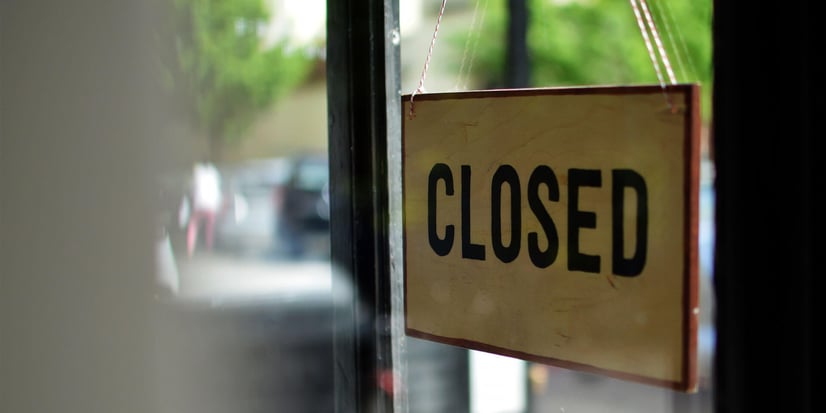LS Retail | 18 June 2018
Why restaurants fail, and how to avoid it

If you are running a restaurant, you know how challenging it can be at times – and that might just be why you love it. The thing is, good food is not all a successful restaurant needs. Your success also depends on great service, the business running smoothly, and on your capacity to manage all non food-related aspects of the business. It’s a delicate balance, and one that’s a challenge at the best of times.
A short lifespan
An oft-cited studyvia Ohio State University claims that some 60 percent of restaurants don’t make it past year one, and 80 percent fail within five years. While these stats may not be accurate across the board, the fact that they exist suggests that there are numerous reasons why it’s easy for restaurants to fail in early stages. Why do so many restaurants have such a (potentially) short lifespan?Lack of ownership and management experience
Owners are often opening restaurants because they’re looking for an investment, but they may be lacking in direct (or even indirect – for example, retail) experience in the whole system. Thus, they don’t have a full comprehension of all of the areas that need regular attending to on a day-to-day basis – for example health and food regulations, logistics management, or even possibly how to keep their staff happy.Lack of staff training and coordination
Leading a team is hard, and it’s not a job for everyone. When you couple this with a general lack of experience in the field, you’re setting yourself up for unhappy campers on all fronts. If there are other factors at play, such as poor hiring practices or low pay, you’ve got yourself more problems adding up.Poor food, service, or organization
It may seem obvious that you want to offer superior food and service, but what does it take to get there? Qualified servers and kitchen staff are two key parts to achieving this goal. And the ability to retain staff is another important component. Consistently poor scheduling, inaccurate accounting systems and inefficient organization will also contribute to boosting operating costs, and will ultimately wear down your overall ability to function well and offer great service. They might even affect your food quality! So, what can you do to ensure your costs are managed properly?Have a clear value proposition
Do you offer something unique? Or do you serve the same kind of food at the same quality as your competition down the street? Think about the value you give your customers in terms of food, ambiance, and experience.- Food: Does your menu tell your story, or is it just a random collection of dishes? One of the restaurants near my house advertises itself as a “healthy Italian” joint. Their menu? A strange mish-mash that includes pasta, club sandwich, chicken tikka masala, and a so-called “Mexican salad”. Not very enticing, right? Have your value proposition clear, and keep your menu consistent.
- Ambiance: Pay close attention to your lighting, table setting (it’s hard to chat comfortably with your companion when you are sitting on top of the people at the next table!), artwork and music. These are all key components when it comes to creating the right atmosphere.
- Experience: Creating a great dining experience starts with staying organized. When the staff is frustrated, orders are coming out late or wrong and requests go unfulfilled, diners won’t have an exceptional time – and as a result, they may consider ordering in next time they feel like springing for a restaurant meal. Step one in creating a pleasant experience is making sure that all parts of your restaurant are able to communicate properly and function as clockwork: orders must reach the kitchen with all necessary information, and end up on the diners’ table in a timely fashion, exactly as they were ordered.
Give your customers that little extra
Why should diners choose your establishment, instead of your competition? There are many things you can do to encourage customers to return to your restaurant.- Make every visit unique with time-limited menus and events. Offering a changing seasonal menu made with local ingredients can be a great way to keep diners interested in coming back – just make sure you keep the selection fresh and unexpected.
- Today technology can help create great moments for your customers – on top of simplifying your work. People don’t care for waiting for their orders to be taken, or for the check to be delivered. Could you benefit from implementing tech that speeds up the dull moments such as mobile Point of Sale for your staff, kiosks or tablets for self-serve ordering, or mobile ordering? The capacity to differentiate yourself using technological innovation could be what makes or breaks your long-term success.
- Think about implementing customer initiatives – a little extra bonus like free refills or a special birthday ice cream on the house can go a long way towards customer retention.
Make it worth it for your staff
One key factor that is often overlooked is the importance of creating a meaningful experience for your staff, as well as for your customers. Managers are so focused on the bottom line that they sometimes forget to put the care and attention into the people that make the whole machine work. And yet, high employee turnover rate is one of the biggest problems of the restaurants industry – according to the National Restaurant Association, restaurants lose on average around $150,000 a year due to employee turnover alone! Careful hiring, scheduling and training programs need to be put into place in order to ensure that the team measures up both as individuals and together. It’s important that the right people are selected and then trained properly. In your training, explain clearly what behavior you expect from your staff in every occasion, give them in-depth knowledge about the restaurant offerings (and a taste of new dishes, so they can give customers useful advice!), and don’t forget to make your brand philosophy clear. After all, these are your main brand ambassadors! Keep the communication channel open – this means making sure that the atmosphere is always positive, and employing technology that helps staff and management communicate effectively in a quick and straightforward manner.Employ tools that give you overview and control
Which software to use may be not be your main concern when opening a restaurant – but trust me, having the right technology can make the difference between having your restaurant run smoothly and actually hindering your daily business (we have heard some interesting stories…). When selecting a system, keep in mind that the work in the kitchen is intricately connected to the front of the house. To make all parts run smoothly – from the waiter sending orders to the kitchen, to the chef preparing them, to the tracking of ingredients and accounting that goes on in the back of house – you must invest in up-to-date tools that connect every team member and point of source. A unified platform that ties everything together and is used in all parts of your business empowers your whole team, gives you all the information you need in real time, and enables the restaurant to function as it should.Your success depends on exceptional organization and service
In order to stick around and be successful you need to be on top of your game at all times, keeping not only your customers, but also your staff and partners in the food industry happy and satisfied. Having the right tools for success is key to the smooth integration of various facets from ordering to kitchen organization to reservations. Want to know more? Send us a line, and our experts will get back to you in no time.

